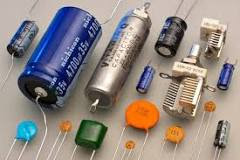Capacitors
In case you face any problem or have any query please.....Read more/visit Us
The capacitor, though sometimes disregarded in favor of flashier competitors like transistors and microprocessors, is a critical component in determining the operation and effectiveness of innumerable electronic devices. In this thorough investigation, we dig into the world of capacitors, learning about their essential principles, many varieties, useful uses, and crucial contributions to contemporary technology.
Understanding the Basics: What is a Capacitor
A capacitor is fundamentally an electronic part used to store and release electrical energy. It comprises of two conducting plates separated by a dielectric, an insulating substance. An electric field is created inside the dielectric when a voltage difference is supplied across the plates, which leads to the buildup of charge on the plates. Electrical potential energy is stored as a result of this charge separation and can be released as needed.
The Farad (F), which bears the name of physicist Michael Faraday, is the basic unit of capacitance. When a voltage differential of one Volt is put across a capacitor's plates, one Farad is defined as the capacitance that stores one Coulomb of charge. However, due to the very high capacitance values seen in electronics, capacitors are typically measured in smaller units like microfarads (F), nanofarads (nF), and picofarads (pF).
Types of Capacitors: A Diverse Array
Capacitors come in a variety of types, each tailored to specific applications and requirements. Let's explore some of the most common types:
- Ceramic Capacitors: These are compact and widely used for their affordability. They come in various shapes and sizes, making them suitable for surface mount technology (SMT) on circuit boards. Ceramic capacitors offer a range of capacitance values, though they can be less precise and exhibit voltage-dependent characteristics.
- Electrolytic Capacitors: With higher capacitance values, electrolytic capacitors are well-suited for applications that require large energy storage. They come in two main variants: aluminum electrolytic capacitors and tantalum electrolytic capacitors. However, they can have limitations like limited shelf life and sensitivity to reverse polarity.
- Film Capacitors: These capacitors use a thin plastic film as the dielectric and offer excellent stability, reliability, and low leakage current. Film capacitors are often used in high-frequency and precision applications.
- Variable Capacitors: As the name suggests, the capacitance of these components can be adjusted. They find use in tuning circuits and variable frequency oscillators.
- Super Capacitors: Also known as ultracapacitors, these capacitors boast extremely high capacitance values and can store and release energy rapidly. They bridge the gap between traditional capacitors and batteries, finding applications in energy harvesting and regenerative braking systems.
- Mica Capacitors: Renowned for their stability over a wide range of temperatures and frequencies, mica capacitors are used in radio frequency (RF) applications and precision circuits.
Applications Across Industries
Capacitors play an integral role in a multitude of industries, influencing technologies that have become essential to our daily lives. Some of their most notable applications include:
- Power Electronics: In power supplies, capacitors smooth out voltage fluctuations, reduce noise, and store energy for peak demands, contributing to stable and efficient power delivery.
- Electronic Filtering: Capacitors are used in conjunction with resistors and inductors to create filters that attenuate certain frequencies in audio and radio frequency circuits.
- Signal Coupling and Decoupling: In amplifier circuits, capacitors couple or decouple AC signals, allowing only the desired frequencies to pass through.
- Timing Circuits: Capacitors, in combination with resistors, are used to create time delays and oscillations in timing circuits.
- Motor Starters: In electric motors, capacitors are used to provide an initial burst of energy during startup.
- Radio Frequency Communication: Capacitors are crucial components in RF circuits, enabling the transmission and reception of signals in devices like smartphones and radios.
Capacitors: Enabling Future Innovations
As technology advances, the role of capacitors continues to expand. Emerging fields such as renewable energy, electric vehicles, and the Internet of Things (IoT) heavily rely on capacitors to ensure efficient energy management, power storage, and signal processing. Furthermore, researchers are constantly striving to enhance capacitor designs, seeking higher energy densities, longer lifetimes, and improved performance.
In conclusion, the unassuming capacitor is a foundational component of modern electronics, enabling a vast array of devices and systems to function effectively. From its inception in the laboratories of pioneers like Michael Faraday to its integration into our smartphones, electric vehicles, and renewable energy infrastructure, the capacitor's significance cannot be overstated. As we move forward into a future defined by technological innovation, capacitors will undoubtedly remain at the heart of progress, quietly empowering the world around us.




No comments:
Post a Comment
if you have any assignment problem please contact us